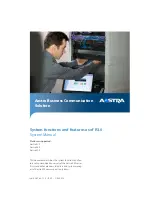
– 230 –
Q-1A QUEUING - ACD
2. Conditional queuing:
One of the two following conditions (programmed on a split-wide basis) will be checked before a call is either
connected to an agent or queued.
a.
Minimum Agent Availability
The system will check for a minimum number of available agents before connecting the call. If the num-
ber of available agents is greater than or equal to the minimum specified, the call is accepted and con-
nected to the longest-waiting available agent. For example, if the minimum agent threshold is set at “3”,
then calls are connected if there are three or more available agents. If there are two or fewer available
agents the call will be processed by the next step in the Call Control Vector (refer to “CALL CONTROL
VECTOR-ACD [C-108A]”).
b. Maximum Queue Depth
The system will check for a maximum number of calls in the split’s queue, at the time the call is pre-
sented. If the queue depth is less than the maximum specified, the call may be queued or connected if
agents are available. For example, if the maximum queue depth is set at “3”, then calls are connected if
there are fewer than three calls in queue. If there are three or more calls in queue the call will be processed
by the next step in the Call Control Vector (refer to “CALL CONTROL VECTOR-ACD [C-108A]”).
A Call Control Vector (CCV), which is assigned to a Pilot Number, allows certain calls to queue to a split, and spec-
ifies standard or conditional queuing. When conditional queuing is used, the type (condition) and threshold must be
selected for the split. A split may receive standard queuing calls from one CCV while receiving conditional queuing
calls from another CCV. Refer to “CALL CONTROL VECTOR-ACD [C-108A]” for related information.
The following types of calls are permitted to queue to an ACD split when agents in the split are not available to
handle calls:
1. Calls to the C.O. trunk assigned to the ACD split.
2. A DID or Tie trunk call that dialed the Pilot Number associated with the split.
3. Automatic Ringdown Tie trunk terminations.
4. Calls transferred by the attendant.
5. Calls overflowed from other splits.
6. Calls forwarded by the split supervisor of another split.
7. Calls transferred by Node stations or ACD agents.
8. Calls transferred by Night mode.
9. Direct station calls.
Summary of Contents for SV8500
Page 1: ...FP85 104 S1 Data Programming Manual ACD NWA 041687 001 ISSUE 1 0...
Page 12: ...PL 6 This page is for your notes...
Page 130: ...114 A 31A ABANDONED CALL SEARCH ACD PROGRAMMING None...
Page 364: ...348 CHAPTER 6 This page is for your notes...
Page 409: ...Printed in Japan 0807 010...
Page 410: ......
















































